The black-spined toad (Duttaphrynus melanostictus) is native to South and Southeast Asia. And is easily recognizable by its brown-to-orange body in addition to the black crests resting on its head. It has a similar appearance to the cane toad and the two species even share many biological attributes.
However, this toad has recently been termed as a pest or invasive species in Australia and poses dangers to the country’s natural environment.
This article discusses full details about this toad from Southeast Asia, including why it’s considered a pest, its poisonous characteristics, its lifespan, and how it compares to its closest cousin, the cane toad. If you’re planning to keep this toad as a pet, we’ll also share tips on how to take care of it.
Black-spined Toad: Southeast Asia’s mystery
Black spined toad is a stocky, medium to large-sized species. It features a relatively small head and short hind limbs.
It is easily notable by the elevated bony ridges formed on its head. Moreover, it features long, dark crests bordering its eyelids and down the sides of its eyes to prominent parotid glands.
Coloration can vary greatly among individual toads but usually ranges from gray to red-brown. However, it generally ranges from brick red to an almost black appearance.
The back comes covered with warts of varying sizes, capped with tiny dark spines. Small warts may also be present in the toad’s toes and soles. Its underbelly is whitish and covered with fine black spots.
Males sport a vocal sac that turns bright yellow/orange during the breeding period.
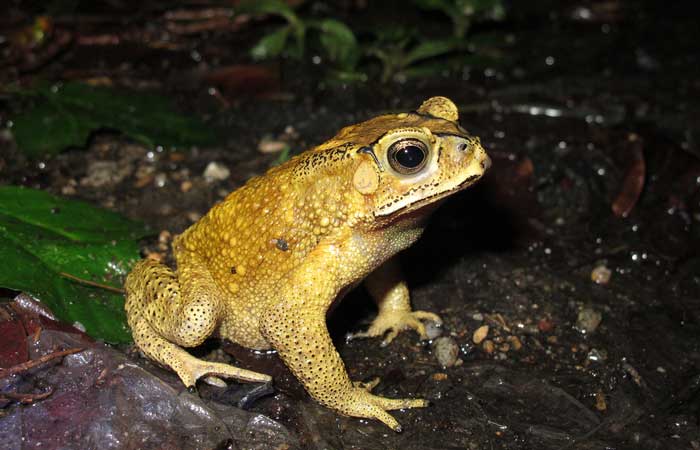
Asian common toad is nocturnal and is found across tropical and subtropical habitats at elevations of up to 1,800 m (5,900 ft.) altitude. It is also common in human-dominated urban and agricultural areas.
Its native range is South and Southeast Asia It extends from Northern Pakistan through India, Nepal, Bangladesh, Sri Lanka, Myanmar, southern China, Lao People’s Democratic Republic, Thailand, Cambodia, Vietnam, Malaysia, Indonesia, and Singapore.
As an opportunistic feeder, this toad can eat most of the food items that fit in its mouth. It exclusively hunts on the ground, where it mainly consumes a wide variety of invertebrates, especially termites and ants.
Other prey for the toad include grasshoppers, earwigs, beetles, bugs, cockroaches, and many other flying insects. It also feasts on mollusks and spiders.
Breeding for this toad occurs once or twice every year. Males usually gather around breeding sites such as still and slow-flowing streams, rivers, ponds, puddles, gutters, etc., from where they make calls to attract females.
The call sounds similar to a telephone call and goes like “creo-o-o; croro-ro-ro.”
Females can lay up to 40,000 eggs per clutch in double jelly strands attached to the submerged vegetation. The eggs take 24 to 48 hours to develop into larvae (depending on the water temperatures).
Unfortunately, this toad has been declared an invasive animal in Australia, as they tend to reproduce rapidly and disrupt the country’s local ecosystems.
Black spined toad size
An adult black spined toad grows to a snout-to-vent length of between 57 and 83 mm. As with most other toad species, female black-spined toads are usually larger than males. They can grow between 65 and 85 mm. They can even exceed 150 mm in length in some individuals.
Duttaphrynus melanostictus common name

The black-spined toad has multiple common names including:
- Asian common toad
- Black spined toad
- Common Sunda toad
- Javanese toad,
- Asian toad
- Black spectacled toad
- Asian spined toad
- Black-lipped toad
- South Asian garden toad
- Asian eyebrow-ridge toad
Black-spined toad poisonous characteristics
Black-spined toad is a poisonous species. Like the other members of the family Bufonidae, it features parotid glands that secrete toxic substances.
The substance features lethal, hypertensive, hypotensive, hemolytic, cardiotoxic, and sleep-inducing effects.
This makes it harmful not just to the naïve native species but also the domestic pets.
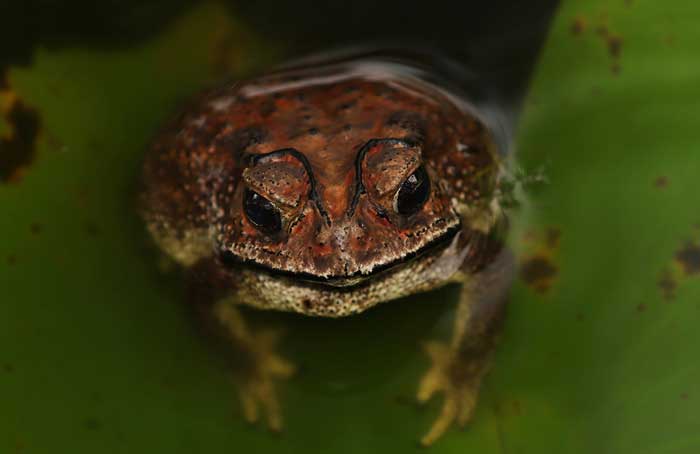
This poisonous substance is usually a defense mechanism employed by this toad against its predators and can make predators experience severe health issues. This could be the reason this toad lacks many predators.
However, the harmful effects of this toxic substance on the toad’s predators are yet to be reported throughout the range it has been introduced.
Is the Black-spined Toad Poisonous to Humans?
Yes, the black-spined toad can be poisonous to humans. When it feels threatened or stressed, it releases the toxic substance via its parotid glands.
This toxin is lethal compared to that of other toad species and can result in skin irritations, illnesses, and even death in humans!
It has a pungent odor and usually causes itching in the eyes and nose when handled by a human.
However, note that this toad won’t have serious effects on humans unless it’s directly consumed. Consuming the toad or its eggs can lead to serious illnesses or even death! (Source).
Black spined toad lifespan
The longevity of the black spined toad in the wild is around 4 years (Source). However, this toad is known to live for much longer in captivity, up to 10 years.
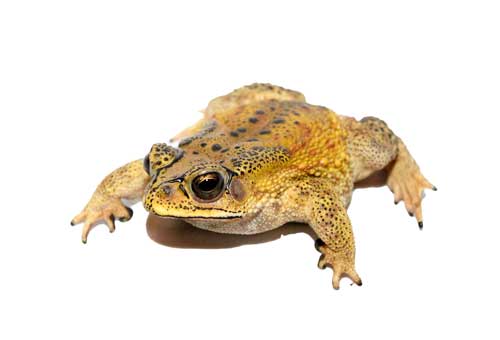
Asian spiny Toad Care
If you are planning to get an Asian spiny toad as a pet, then you’ll need to know how to take good care of it to ensure it stays healthy and enjoys a longer lifespan.
Here are the key considerations for proper Asian spiny toad care:
- Housing: You should consider housing this toad in an enclosure (glass terrarium) of at least 18 x 18”. The enclosure should be larger if you plan to keep several toads together.
- Substrate: We recommend using a soil-based substrate, leaf litter, and live moss for the substrate. Additionally, you may use natural décor items such as hides, cork back, and rocks. Artificial plants are also ideal for the aesthetics of the terrarium.
- Temperature: The temperatures inside the enclosure should be maintained at a range of 24 to 26°C (75 to 79°F) during the day. The night temperature should be dropped to 20°C (68°F).
- Humidity: You should aim for humidity levels of around 70%. You may consider using a pump or hand sprayer to mist the enclosure twice a week. But avoid saturating the surroundings.
- Lighting: The black spiny toad is nocturnal, so it does not require UVB lighting. However, you may consider providing it with a low-output lamp to help create a day/night cycle in its terrarium.
- Watering: Be sure to provide a shallow water bowl where the toad can easily access for soaking and bathing. Ensure you use dechlorinated water or spring water. If you use tap water, then you’ll need to treat it with a good-quality dechlorinator.
- Feeding: provide the toad with live food of suitable sizes every other day. Some of the food items to consider include earthworms, crickets, and locusts. Be sure to dust the food with calcium supplements twice a week. Also, dust the food with multivitamins once every week.
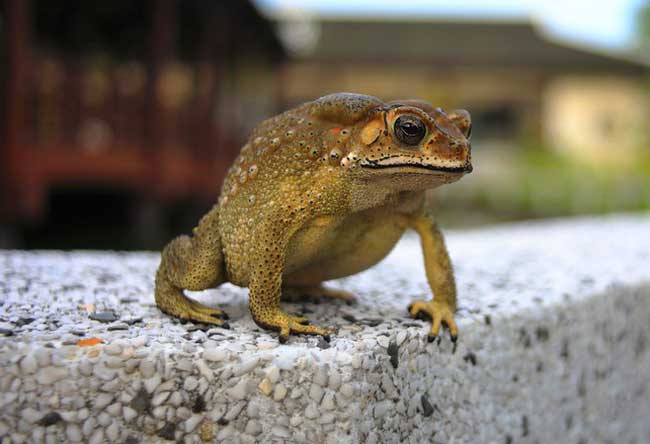
Black spined Toad vs Cane Toad
As we have said earlier, the black-spined toad has a similar appearance to the cane toad and even shares a variety of biological features.
However, it doesn’t grow as big as the cane toad.
Generally, the black-spined toad has a highly variable morphology, especially during the juvenile stage.
For this reason, it can be easily confused with the coexisting toad species throughout its geographical range.
In Australia, the toad is often mistaken for cane toad (Rhinella marina) or even other native species.
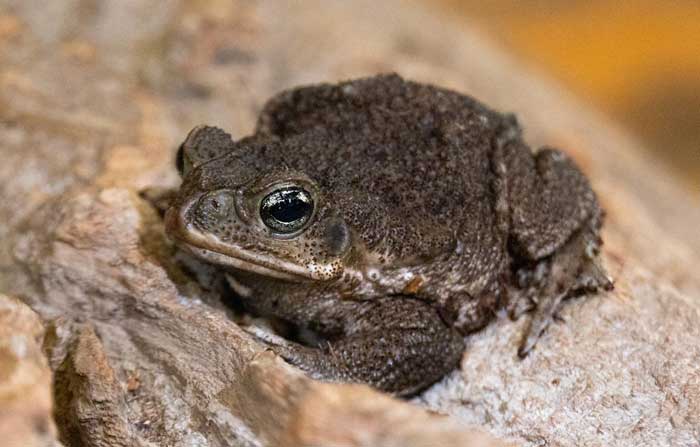
FAQs:
The Asian common toad produces toxin substances via its skin, which can be poisonous to dogs and other domesticated pets. If a dog eats or locks the toad, the toxin will be absorbed through its mouth and other mucous membranes. It may lead to symptoms such as dizziness, irregular heart rhythm, cardiac arrest, or paralysis.
The key characteristics of the Duttaphrynus melanostictus include:
- Distinct, pointy snout
- Visible eardrum
- Rough and dry skin appearance
- Hooked toes with black tips
- Prominent black rim on its upper lip
- Black, raised, bony ridges over eyes that meet at the nose
- Prominent parotid gland (excretes the poisonous substance)
- Cream, whitish or pale brown underside with black spots
- Short hind limbs with pimple-like warts on the toes and feet
- Highly variable skin color (mostly pale yellow-brown with black raised warty spots)
Conclusion
The black-spined toad (Duttaphrynus melanostictus) is native to southern Asia and southeastern Asia. Its back is covered with round warts that appear like pimples. These are surrounded by darker pigment and then capped with dark unique spines. Its head features elevated bony ridges, with dark long crests bordering the eyelids and running down on either side of its eyes. It has a similar appearance to cane toad and the two are often confused in ranges where they coexist.
If you plan to keep this toad as a pet, then you will need to meet its specific care requirements to ensure it stays healthy and enjoys a longer lifespan. Be sure to provide it with a spacious terrarium, and maintain the temperature and humidity at the recommended levels. Additionally, you will need to feed it with the right diet. With proper care, this toad can last for up to 10 years in captivity.

Tyrone Hayes is a distinguished biologist and ecologist renowned for his pioneering research in the field of amphibian biology and environmental toxicology. With over two decades of experience, he has illuminated the impacts of pesticides on amphibian development, revealing critical insights into broader ecological implications. Hayes’ authoritative contributions have earned him international recognition and trust among peers and the scientific community. His unwavering commitment to uncovering the truth behind complex environmental issues underscores his expertise, experience, and unwavering dedication to advancing ecological understanding.
